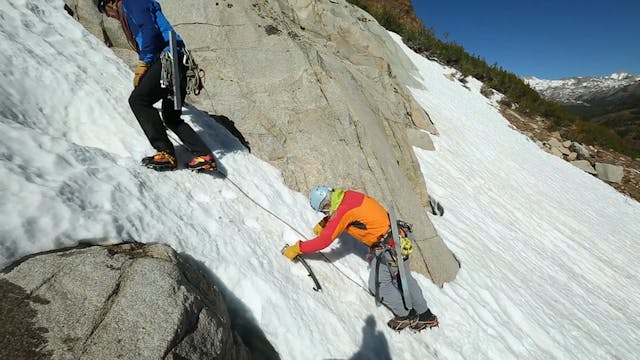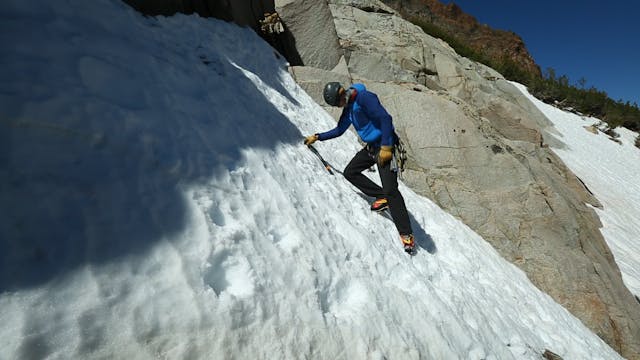In this video we look at how to chop steps for climbing snow.
There are times in the mountains when most of the terrain will be on rock, trails, and talus. This is typically late summer or in the autumn, or lower elevation alpine areas following a lean winter. Sometimes you may choose to leave crampons behind, but still carry a lightweight ice axe. When you are faced with a section of firm snow without crampons, it pays to have practiced the art of step cutting.
“Step Cutting” or “Chopping Steps”, was the technique used by guides in the Alps, prior to the development of crampons for alpine climbing. The axe is swung up-hill, often using the adze, and creating two steps. You will then take two steps up, and repeat the cutting.
Step 1: Swing your ice axe to create a platform in the snow or ice for the upper step.
Step 2: Then swing your axe for the lower step.
By creating the top step first, you reduce the amount of snow that fills in the step you just cut.
Below are considerations for chopping steps:
1. The amount of swings and force you use depends on the firmness of the snow or ice.
2. Swing with an arc, using the adze to scoop out the step.
3. Remember, you will be moving into an out of balance step and then back into an in balance step when you move twice. Always chop your steps from an in balance stance: this is with your uphill foot forward.
We hope you found this video helpful. Feel free to comment below with questions or thoughts!
Please remember, climbing is inherently dangerous. Climb at your own risk.
Up Next in Alpine & Mountaineering
-
Alpine: 5. Snow Travel - Duck Foot
In this video we look at the duck foot technique for climbing snow.
When ascending up a snow slope of moderate angle, the most efficient method may be the duck foot method. The French term for this is “pied en canard”. It is similar to the herringbone technique that a skier would do to ascend...
-
Alpine: 6. Snow Travel Considerations
Snow is an incredible medium on which to travel, and often provides efficient travel conditions. In this video, we look at various aspects of climbing on snow.
Perfect spring “corn” snow that is well consolidated and soft enough to take a boot kick or ski edge, or firmer snow that takes crampo...
-
Alpine: 7. Efficient Snow Travel
When getting into mountaineering, it is worth it to invest time in learning and practicing the most efficient stepping techniques. Mountains can be huge, and involve lots of steps. The more efficient you are with each one, the further you will be able to climb.
As the saying goes: how do you e...



2 Comments